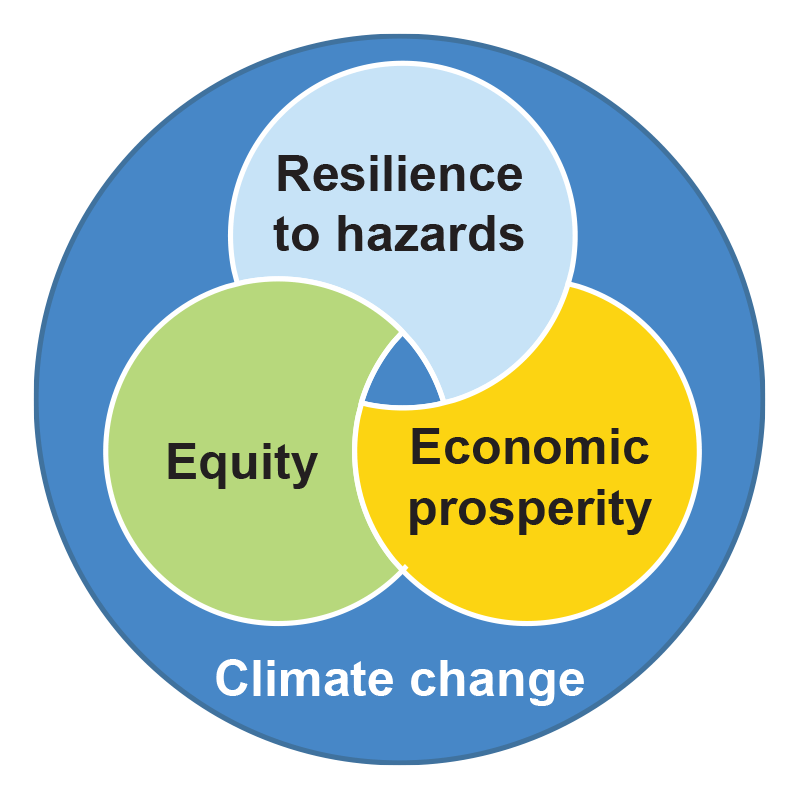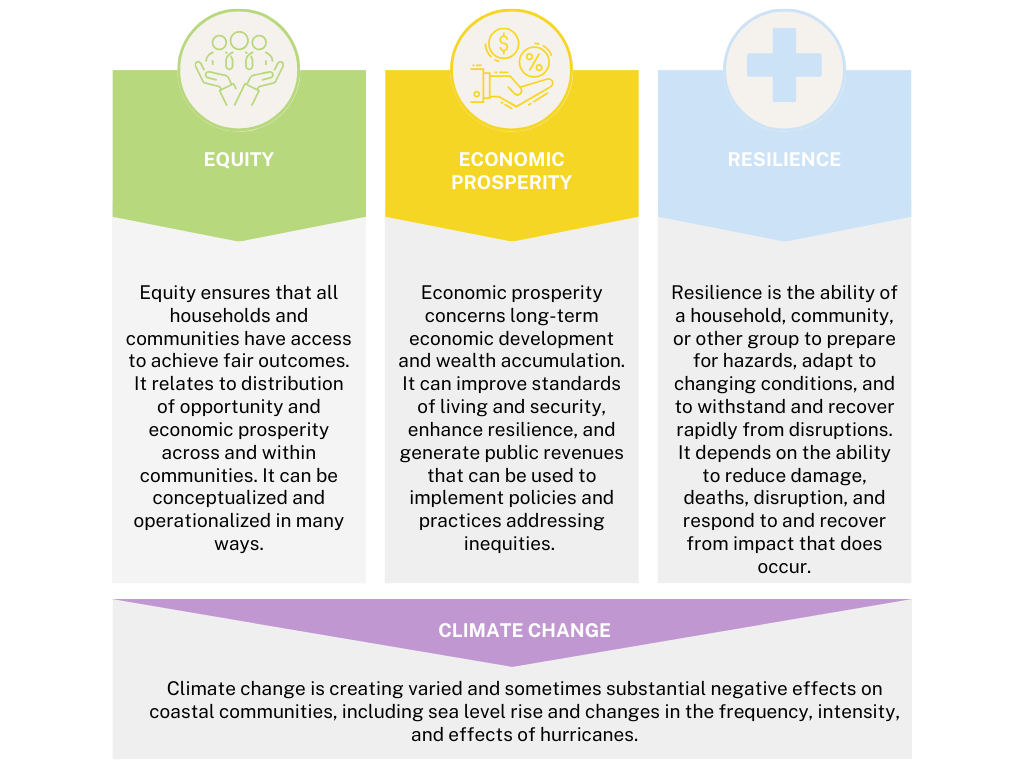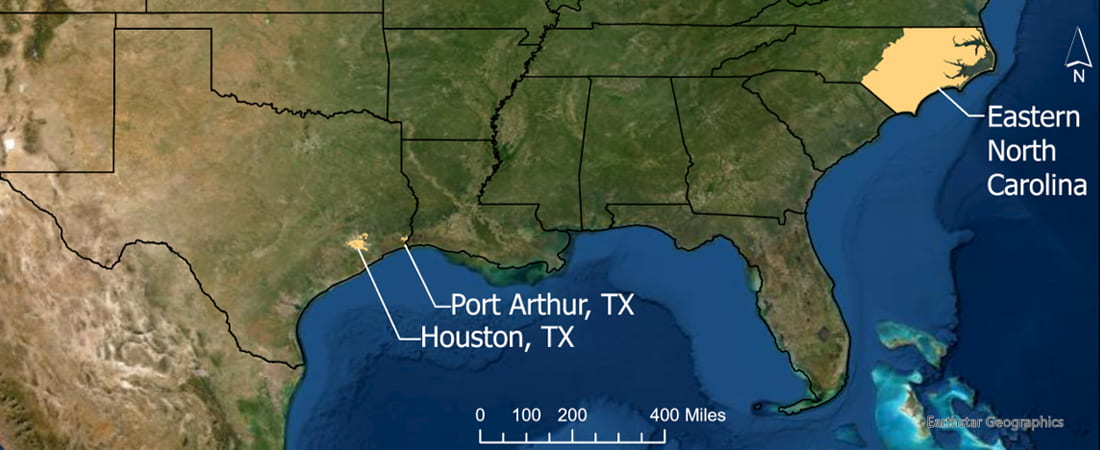Research
Our Research
Hub research will advance knowledge by identifying, explaining, and quantifying the complex interactions among the coastal community goals of equity, economic prosperity, and resilience to hurricane-related hazards, both now and in the future.
THE PROBLEM
In less than a decade, Hurricanes Harvey, Irma, Maria, Florence, Michael, Laura, Ida, and Ian have each cost the U.S. more than $25 billion in damages, destroying homes and businesses, and upending life in hundreds of communities. The devastation repeats. Each event exacerbates inequities in our country, and the damages continue to compound as climate change intensifies hurricane severity and frequency.
The current system for managing natural disaster risk in the U.S. has evolved over time but is still widely acknowledged to be problematic, insufficient, and short sighted. Community resilience to hurricane wind and flood damage remains challenging to achieve in practice, especially when also considering the issues of equity, economic prosperity, and climate change. This is where the Hub comes in.
We hypothesize that part of our inability to find sustainable solutions that mitigate the effects of hurricanes is that we have overlooked the competing goal of economic prosperity and have not incorporated equity principles. This prevents affected and vulnerable populations from being able to break the cycle of destruction and achieve resilience

OUR APPROACH
The CHEER Hub aims to provide a new approach to managing hurricane risk by focusing on three competing goals: economic growth, equity, and hurricane resilience. Each of these challenges on its own is a complex and expansive topic, so it is daunting to consider addressing all of them together. It is the tension among the three community goals and the dynamic context of the climate that is challenging coastal communities. To make a leap forward in sustainable risk reduction, resilience, equity, economic prosperity, and climate change cannot be considered in isolation. These interactions are the focus of this CoPe hub.
In particular, the Hub identifies and explains how equity and economic development shape resilience to hazards and vice versa, and the influence of climate change on all three goals. We represent these ideas in a mathematical modeling framework to quantitatively explore their complex interactions. Equity and economic prosperity have been virtually absent from previous engineering models developed to support risk management decision-making. The Hub focuses on households and housing, which play critical roles in equity, economic prosperity, and resilience. Recognizing this effort requires an active approach. We are applying lessons from and contributing to the scholarship of convergent research.
OUR RESEARCH GOALS
- Identify, explain, and quantify the interactions and tradeoffs among the coastal community goals of equity, economic prosperity, and resilience to hazards.
- Develop methods to model long-term hurricane hazards in a way that accounts for climate change and integrates wind, rain, storm surge, and wave hazards.
- Develop a computational tool to help design policies that can achieve sustainable equity, economic prosperity, and coastal resilience in the context of climate change.

Our Focus Areas
COMPUTATIONAL POLICY ANALYSIS TOOL
The CHEER Hub is developing a computational policy analysis tool that can help design and evaluate policy interventions that balance equity, economic prosperity, and resilience to hurricanes. It is called the Stakeholder-based Tool for the Analysis of Regional Risk (STARR). This tool will help generate solutions that are more likely to garner support, achieve equity goals, and provide insight on win-win interventions that benefit both individual stakeholders and society at large.
A SYSTEMS APPROACH
MULTIPLE STAKEHOLDERS
No single stakeholder can solve the problem of hurricane risk alone. The CHEER Hub explicitly acknowledges and accounts for the individual points-of-view of different stakeholders, including households, government agencies, and insurers. The Hub recognizes that each group has their own risk, objectives, alternatives, constraints, risk attitudes, timelines, and decision making processes. It therefore explicitly represents how they make their own decisions and interact with other stakeholders.
MULTIPLE STRATEGIES
No single intervention can solve the problem either. The CHEER framework accounts for multiple diverse interacting interventions–including property acquisition, retrofit grants, insurance, and land use policies–each of which has different costs, effects on risk, and benefits.
INTERDISCIPLINARY
The Hub tightly integrates insights from a broad range of disciplines. This includes the relationship between micro (e.g., individual-level decisions, culture, language) and macro (e.g., community, government, economy) aspects of social systems that reproduce loss and inequity. This value is also reflected in the Hub’s deliberately diverse team, including their researchers, staff members, and partnerships.
CONCEPTUALIZATION OF DISASTERS
CHEER views disasters as a natural part of a community’s evolution rather than an unexpected exogenous event, and disaster risk management as inextricably interwoven with the normal activities of everyday life.
INTENTIONAL AND UNINTENTIONAL PROCESSES IN EVERYDAY LIFE
The Hub considers the decisions and actions that are intended specifically to improve resilience to hazards, equity, or economic prosperity as well as those that unintentionally or indirectly influence them in some important way.
CASE STUDY AREAS
The Hub conducts research in three case study areas – Eastern North Carolina; Port Arthur, TX; and Houston, TX.



